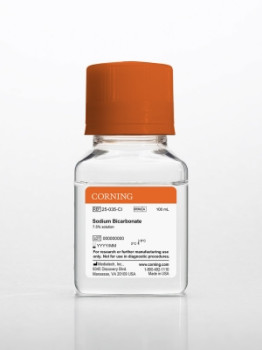Corning® Buffers
By Corning®
See below for more information on buffering systems.
F = -5 to -20°C
R = 2 to 8°C
A = 15 to 30°C
* = Glass
** = Flexible Media Bag
I = Sterile, IVD Product
NI = Sterile, Research Use Only, Not for IVD Use
IVD = In Vitro Diagnostic
Res = Research Use Only, Not for IVD Use
Buffering Systems
Maintaining the pH of the cell culture medium is critical to cell viability. Most cell lines grow well at pH 7.4 and are inhibited in growth at a pH of 6.8. Glucose is usually the sugar included in media and is metabolized by the cells very rapidly, at a rate faster than it is needed. Byproducts of this metabolism include pyruvic and lactic acids and CO2. One way to reduce the amount of lactic acid is to replace the glucose with other sugars such as galactose or fructose. These are utilized at a slower rate, but also result in a slower rate of cell growth. This replacement, however, can slow down the onset of a pH shift.
The bicarbonate and carbon dioxide buffering system is most commonly used to maintain physiological pH (7.2-7.4) of a culture. Bicarbonate is a weak buffer with a pKa of 6.1 making a pH range of 7.2-7.6 more difficult to prevent rapid pH changes. Bicarbonate, however, is less expensive than other buffers, is non-toxic, and has nutritional value.
Bicarbonate/CO2 Systems
The amount of dissolved CO2 in water is dependent on the amount of atmospheric CO2 and the temperature. Increasing CO2 tension in the absence of sodium bicarbonate leaves the medium acidic.
H2O + CO2 ↔ H2CO3 ↔ H+ + HCO3
The addition of sodium bicarbonate in the presence of CO2 will drive the equation to the left to allow for an equilibrium to be achieved and the pH maintained at 7.2-7.4.
NaHCO3 ↔ Na+ + HCO3
Although CO2 is produced by growing cells, it is not produced in a high enough level when growing at a low cell density or during lag phase to maintain an optimal pH. Use of a CO2 incubator is a good way to control the CO2 tension and the temperature. Depending on the type of CO2 incubator used, calibration should be regularly performed to ensure the correct CO2 tension is being maintained.
Organic Systems
Organic buffers such as HEPES (N-2-hydroxyethylpiperazine-N'-2-ethanesulphonic acid) do not require elevated levels of CO2 and provide an alternative to the use of bicarbonate for buffering. Unlike the low pKa of bicarbonate, HEPES has a pKa of 7.66 making it a much stronger buffer in the pH 7.2-7.6 range. Disadvantages to using this zwitterionic buffer, however, are cost, toxicity, and lack of nutritional value. Recommended usage of HEPES is at concentrations of 10-25 mM; toxicity to cells can occur at a concentration over 100 mM. HEPES may be used in addition to bicarbonate for added buffering capacity. It is important to maintain sufficient bicarbonate in the medium for nutritional purposes even if HEPES is being used as the primary buffer.
NOTE: Most powdered cell culture media are deficient in sodium bicarbonate. Please refer to the formulations to determine the amount of bicarbonate to supplement.
